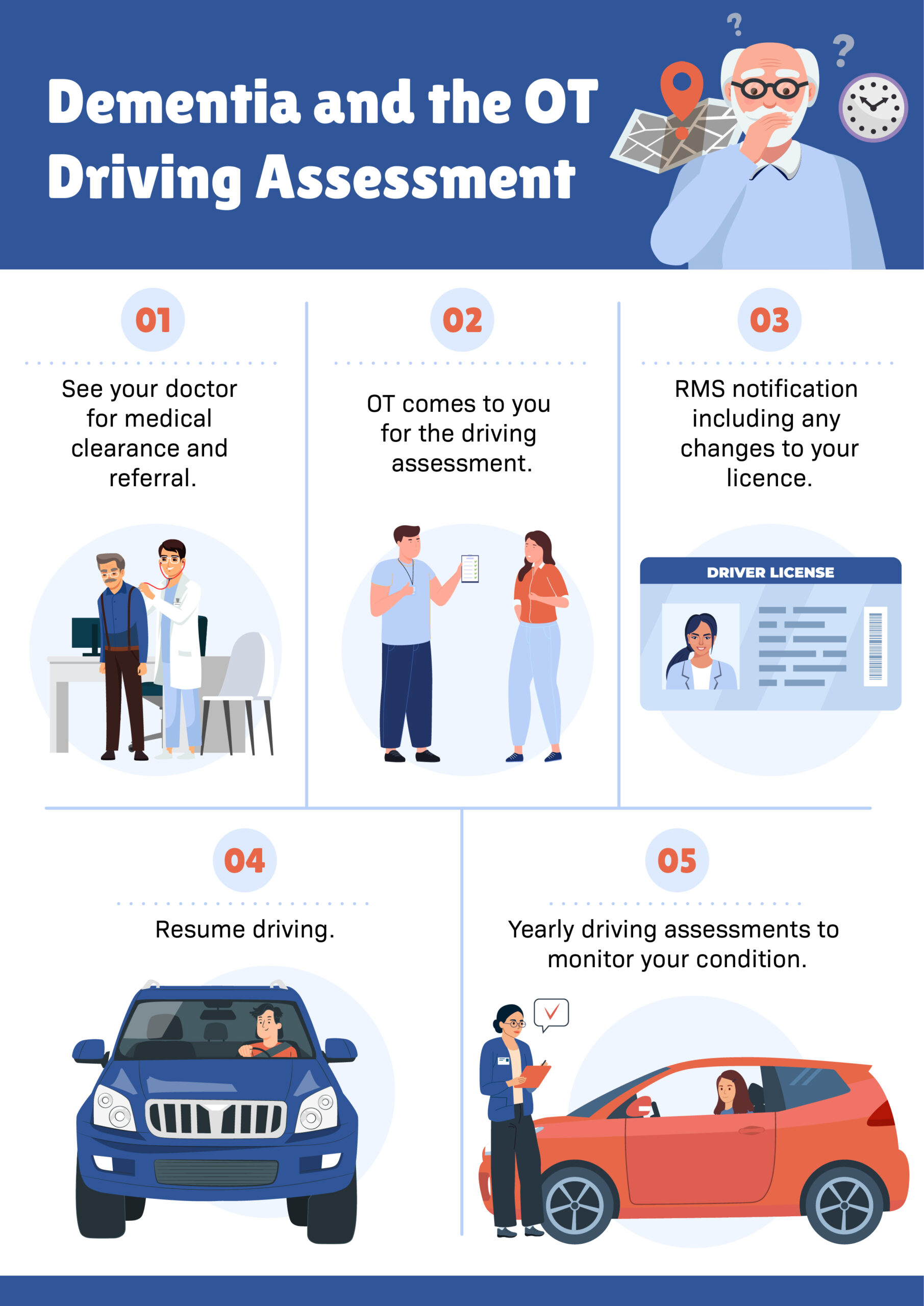Dementia background
Although dementia is a serious illness, dementia often does not harmfully influence a person’s driving skills until its later stages. Thus, even if a driver has been diagnosed with dementia, they can often still continue to drive for some time. Like any other medical condition, the way dementia affects driving differs between individuals. However, the earlier the disease is identified, then better the prognosis will be for the person. Dementia is a general term that is used to describe declining cognitive skills caused by brain cell damage. One of the most common forms of dementia is Alzheimer’s disease.

While a diagnosis of dementia does not necessarily mean that the sufferer must cease driving immediately, it is a degenerative condition that causes the person’s driving ability to diminish over time. Indeed, even irrespective of driving and in the person’s general life, dementia leads to a lowering of one’s daily functioning. A person who is showing signs of dementia can exhibit some early warning signs including deficits in short-term memory, becoming lost in unfamiliar places, increased disorganisation and changes in their behaviours. This degeneration and progression of the illness is different for everyone. However, once a diagnosis of dementia is established, it is generally advised that the person’s family begins to prepare them for the likelihood that they will have to cease driving at some stage. These difficult decisions are made in discussion with the person, their family or carers, and under the guidance of their doctor (GP, geriatrician or other specialist).
Learn when to stop
Perhaps the most important decision to make when it comes to dementia and driving is deciding when it is time to stop driving. In any case, any sufferer of dementia in the early or mild stages of dementia must be evaluated immediately if they wish to continue driving. The usual process involves the person’s doctor assessing their medical fitness to drive, then referring them for an OT driving assessment. When a diagnosis of dementia has been made, the RMS must be notified. This notification is usually made by the person’s doctor, who will perform an assessment regarding their medical fitness to continue driving. In most cases, the doctor will recommend the person to undergo an Occupational Therapy (OT) driving assessment. In instances where the dementia has progressed to a severe and advanced stage, the doctor has the authority to cancel the person’s licence immediately (without undergoing the OT driving assessment).
The OT driving assessment’s purpose is to perform a practical driving test. Driving is an activity that is difficult to assess without witnessing the person drive. As doctors do not observe people driving, they refer the person to a qualified Driver Trained Occupational Therapist to complete the assessment. The OT driving assessment is the process endorsed by the RMS to fully determine a person’s medical fitness to drive.
In the assessment, the OT’s specific focus is on assessing how dementia is affecting the person’s current driving abilities. It is expected that the person abides by road rules and can follow instructions, as well as self-direct to/from a familiar place. The assessment is conducted at the person’s home and they drive around their local area. In general, if the person makes nil errors that require physical intervention (i.e. activating the dual control brake or taking control of the steering wheel), the person will likely have a favourable outcome. However, if the person commits mistakes that require physical intervention, it will likely result in an assessment ‘fail’. In these cases, the person will usually require undertaking driving lessons and an OT driving re-assessment to try to maintain their licence. Also, as it is common for drivers with dementia to struggle with driving when in unfamiliar places, a kilometre restriction on their licence may be an option. This can be discussed with the person and their family, doctor and the OT, and will also depend on the person’s need for driving.
If the assessment’s outcome is that the person is still driving safely, they can continue to drive for the time being. However, as dementia is a progressive illness, they will need regular monitoring and OT driving reassessments to continue driving. Usually, assessment periods are every 6-12 months, but can be more frequent depending on how the illness progresses.
Behavioral indications
As dementia is volatile in nature, it can be difficult to assess how the illness develops. As such, it is often a challenge to determine when a sufferer is no longer capable of driving safely. A person’s cognitive functioning can be determined by the following common behavioral indicators:
- Progressively less coordinated
- Experiencing problems in judging distance
- Experiencing problems when information processing
- Experiencing decision-making issues
- Increased memory loss
- Experiencing multi-tasking problems
- They are becoming disorientated or lost in what were familiar places
If the family or friends of a person diagnosed with dementia begins to recognise some of these signs, it is crucial to pay closer attention to the person’s behaviour. These concerns should be discussed with the person’s doctor as soon as possible, as it is likely to have some affect on their driving capacity.
Always monitor their driving
It is important to understand that dementia can deteriorate cognitive functioning by an extreme degree in a very short period of time. This means that even if the person is still driving safely, the degeneration of the disease may accelerate and rapidly decrease their skills. It is important to narrow down and determine the period in-between and stop them driving before a serious problem can ever occur (e.g., they cause an accident while driving). As the person may have poor insight into their own situation, it often becomes their family’s responsiblity to monitor and oversee their driving. Moreover, it is often difficult for people to accept that they may no longer be able to drive.
Below are some common signs that may indicate that the person’s driving skills are deteriorating:
- They’ve drive too slowly (significantly below speed limit)
- They stop in traffic or ignore signs without reason
- They become lost in places that they should be familiar with
- They lack proper judgment and are making poor decisions
- They have difficulty performing normal driving techniques
- They are signaling incorrectly
- Their concentration decreases
- They are disorganised and unable to multi-task (e.g. talking to a passenger whilst driving)
Have a plan if they insist on driving
For many people, being able to drive is a large part of their freedom and independence. Having to cease driving will likely have a huge impact on their everyday life and ability to maintain employment, visit family and friends, and engage in social or recreational activities. Unfortunately, due to the depreciating cognitive function associated with dementia, the person will usually have poor insight into their situation and will be unable to recognise that they should not be driving.
If they can no longer drive due to their dementia but are unable to understand or accept this, it is important for families and caregivers to provide support and develop strategies to maintain the person’s safety. In some cases, families may need to utilise measures such as:
- Disabling the car
- Selling the car
- Replacing the car keys
- Moving the car out of the person’s sight
- Hiding the car keys out of their sight
While these suggestions may appear extreme, they may be necessary when a person does not understand or cannot accept that they can no longer drive.





